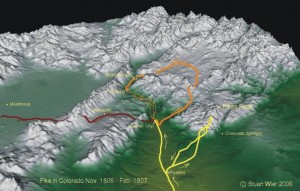Review by Ed Quillen
Geology – March 2007 – Colorado Central Magazine
Ancient Denvers – Scenes from the Past 300 Million Years of the Colorado Front Range
by Kirk R. Johnson and Robert G. Raynolds
Paintings by Jan Vriesen, Donna Braginetz, and Gary Staab
Published in 2006 by Fulcrum with the Denver Museum of Nature and Science
ISBN 1-55591-554-X
GRANTED, THIS SHORT BOOK with many illustrations would be of more local interest if it were called Ancient Central Colorados. But our geologic history is closely related to that of the Denver Basin, and if you can understand what happened there during the past third of a billion years, you shouldn’t have much trouble with our geologic story.
Most of it is pretty much the same, anyway. This saga starts with the Ancestral Rockies, which rose 300 million years ago. Like the modern Rockies, they ran in two roughly parallel north-south ranges, but somewhat to the west of the current ranges.
We know about these ancient mountains because of the sediments that eroded from them — sand formed from reddish granite similar to the rock of Pike’s Peak. Over time, as other sediment overlay it and compressed the sand, it became sandstone known as the Fountain Formation.
It’s what you see at Garden of the Gods near Colorado Springs, or the Flatirons above Boulder, where later uplift tilted the rocks and exposed them. There aren’t many fossils in the Fountain Formation (formations generally get their names from the area where they were first described by a scientist), but there are remains of “scale trees” — 100 feet tall, and green all over, because the entire plant, not just the leaves, was photosynthetic.
The Ancestral Rockies eroded down, and the detritus (eroded sand and gravel) almost buried them. If it seems odd that detritus can get that deep, recall that the San Luis Valley is filled with at least 8,000 feet of detritus; its bedrock floor is below sea level.
Indeed, a part of the Valley comes to mind in the artist’s version of 280 million years ago — immense sand dunes with a tree-lined creek in the foreground. These wind-blown dunes compressed to form Lyons Sandstone.
It doesn’t take a fast rate of erosion to wear down mountains. At a rate of 1/70 of an inch a year, a 14,000-foot peak would be reduced to sea level in a million years. By 250 million years ago, Colorado was worn down nearly to sea level. The Ancestral Rockies were just small lumps in a shallow sea.
Much of Colorado sat along a shallow sea 100 million years ago. The sandstone formed then — Dakota sandstone — came from an ancient beach. Geologists know this because there are ripple marks produced by shallow water, embedded mud from receding tides, burrows from shrimp, and thousands of dinosaur tracks.
The land continued to sink, and by 70 million years ago, all of Colorado was 600 feet underwater. The Pierre Shale produced then underlies Denver and Colorado Springs, and appears as Mt. Garfield outside Grand Junction.
And then came the modern Rockies — the result of uplift that started 66 million years ago known as the Laramide Orogeny. Colorado was wet and lush then, and a home for Tyrannosaurus Rex.
Just a million years later, disaster struck most life on earth — an immense meteorite hit the Yucatan Peninsula of Mexico. The fireball started a global conflagration, and the soot in the sky blocked the sun. It was the end of many plants — and the dinosaurs.
The mountains provided some shelter for smaller creatures, but they also generated dangers with widespread vulcanism. The volcanic activity, though, produced hot water laden with minerals that seeped through cracks and faults to produce the gold and silver deposits so eagerly mined for the past 150 years.
Life recovered. The Gulf of Mexico was closer then, so Colorado got up to 100 inches of rain a year, which produced profuse plant growth which turned into coal seams. The Rockies eroded and the valleys filled with detritis.
CENTRAL COLORADO directly enters the picture 37 million years ago — an immense volcanic eruption in the Collegiate Peaks which spread lava for hundreds of miles. The rock atop Castle Rock came from that volcano. Floods roared across this plain of rock; the fossils at Florissant Fossil Beds National Monument were formed at this time.
By then, Colorado was a vast plain, but further uplift raised the Rockies out of their detritus, and then glaciers formed the Colorado we know today.
All this is explained clearly in this little book, which is aimed at non-experts like me who want a general idea of what happened over the eons. While it would be nice if Ancient Denvers had explained features like the Rio Grande Rift in our region, it wouldn’t be such a simple and short book if its coverage area were expanded.
It does explain the major rock formations and how they got there, and points out places to see them the next time you visit the Front Range. It looks like a good book for kids as well as adults, and the artists’ conceptions help you visualize what you read in other books, like the excellent Roadside Geology of Colorado. And Ancient Denvers doesn’t merely illuminate the varied and violent development of Colorado’s flat front range piedmont, it gives you a better grasp on our elevated geography, too.

